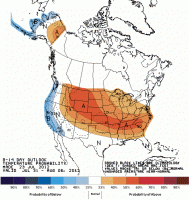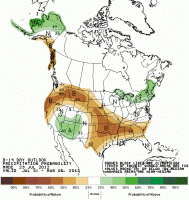By Peggy Whetzel
The U.S. Drought Monitor is forecasting the drought in the Midwest to continue through September 30.
I don’t miss the roar of lawnmowers, the humidity, powdery mildew, mosquitoes or Japanese beetles. But I do miss the butterflies and fireflies. And I worry about the wildlife.
Should we conserve our water and let our native plants and wildlife get through this drought as best they can? Or do we keep our oases going?
With yards as hard as ironing boards, what are robins eating? With so few bugs, are wrens starving? Where will the few butterflies and hummingbirds find nectar? Ironically, about the only plants I see blooming along the road are chicory and drying Queen Anne’s lace.
So I’ve been watering to keep the sunflowers, bee balm, milkweeds, Joe Pye weed and elderberries going. I confess to putting big bowls of water and peanuts in the shell out for the raccoons, and small bowls of water with rocks out for wasps and bees. All of a sudden, the back window looks like wildlife TV. Birds I’ve not seen all year are visiting, including one I’ve never seen in my yard and can’t identify.
And I feel a sense of urgency. What now?
 William deBuys, in his eloquent book, A Great Aridness: Climate Change and the Future of the American Southwest, lays out evidence that our world is getting drier, even as seas rise, as he puts it, as though someone had unplugged the refrigerator. He writes about researchers who have stepped away from the back-and-forth about the occurrence of climate change (“Is not!” “Is too!”), investigating what really happens when plants and trees die off, when fires rage, when there’s not enough water to go around, and taking a look at the prehistoric and historic record for evidence of drought and plenty. He also looks at public policy to see what’s being done, if anything, to stave off the consequences. It is one of the best-written books I have ever read.
William deBuys, in his eloquent book, A Great Aridness: Climate Change and the Future of the American Southwest, lays out evidence that our world is getting drier, even as seas rise, as he puts it, as though someone had unplugged the refrigerator. He writes about researchers who have stepped away from the back-and-forth about the occurrence of climate change (“Is not!” “Is too!”), investigating what really happens when plants and trees die off, when fires rage, when there’s not enough water to go around, and taking a look at the prehistoric and historic record for evidence of drought and plenty. He also looks at public policy to see what’s being done, if anything, to stave off the consequences. It is one of the best-written books I have ever read.
I bring this up because last week my neighbor mowed his dried-up lawn of Bermuda grass. He’s not a foolish man. And mowers along the highway seem determined to reduce everything to stubble and dust, surely not a wise move ecologically or economically.
I don’t see much discussion of the paths we need to take in Missouri, not in terms of public policy or our own backyards.
What do you think we should be doing? And why didn’t anybody warn us?




Well done, Peggy. I think we were warned. It’s just hard to believe until it happens.
Dry and wet patterns do really happen from time to time.Im not ready to say its over just yet.Was it about 4 years ago st louis had 20 something inches of rain in the spring?A wet record.
I have been putting out fresh water with in the late afternoon for the birds and am still watering my plants; thus they are still blooming; providing nectar for bees, etc.
I have seen more reptiles near my house seeking shelter and water.
The Mississippi is low, but there’s still a lot of water there. The St. Louis (city) water division said this week that they’re opperating at 55% of capacity. Looking down from the chain of rocks bridge at the source of our water, it seems like there’s more than enough for watering trees and trying to keep a few things alive for future seasons.
My neighbor has washed his car twice this month though, and that seems a little different.
Nice post, Peggy.
I’ve been expecting this, and that’s one of the reasons I planted natives when I started my garden.
For now, my mantra is
FORGET THE LAWN, SAVE THE TREES.
Peggy, Thanks for bringing up this subject. I think we should discuss this as a group. I too have watered some parts of my yard, but others I have left alone to see what happens. Even with the watering, all of my jewel weed has disappeared. Last year I had over 50 plants bloom.
The early spring has also changed things in my yard. Some things came up too early when it got hot and died before they bloomed.
Kathy Bildner
Very good post and comments. I live on a farm with livestock and am also on a well. So we engaged in massive water conservation beginning in May. Dry winter/dry spring = trouble, almost always does. dry brings dry- as old farmers say. Here is what I did in May as I suspected a challenging summer although NOT this challenging.
I compost all the manure, straw, hay, leaves, yard/kitchen waste. This spring, I put layers of wet newspaper down on all of my extensive native plant beds, around my shrubs and trees. I hauled load after load of ready compost and stacked it on five to six inches thick. I know experts say three inches to maybe four so plants can breathe. But five to six has actually worked well this year given the intense heat, the wind, the relentless sun.
We save almost every bit of water here on the farm- from the kitchen, our “showers” to the animals’ water tanks and any other water used outside. This collected water is poured directly at the roots of all plants on a four-day rotation. Trees get two inches of water every other week at the drip line and two inches in from the line. Small shrubs get an inch every four days, large, established shrubs get two inches every other week.
I am now hauling water from a local pumping station to fill the livestock tanks- 100 gal per tank- so as not to tax my well too much. We clean the tanks daily- so all the leftover water is pulled out with a bucket and hauled to the gardens. I also use any leftover water from the hauling tank on my gardens. BUT- this is chlorinated water and not my well water. I have noted my plants aren’t as happy with the hauled water as with the well water.
When I have to hose off an animal to bring the body temp down during peak heat of the day- I bring the animal out to stand next to one of my gardens and hose toward the garden, turn the animal to hose his other side but still toward the garden.
So far everything on my farm is still alive and looking okay-not great but okay. I have many varieties of bees, snakes, skinks, birds, coons, deer, you name it. The butterflies are just beginning to arrive- not many but some. Have chrysalis’ on some of my host plants. Don’t know if they will make it after they leave my farm, but at least here, they have food, water and rest. I do put out all types of containers of water for insects and larger species. BTW: the Cup Plant is a magnificent means of providing water to all kinds of insects, butterflies and small birds. Just sprinkle water over the plant, the leaves fill with and hold the water. Stand back and watch the little guys come in for a drink and a bath! My natives are all ok- not thriving but ok. My motto for this summer’s watering of plants: “the goal is to survive, they don’t have to thrive!”
Gee- kinda the way I feel about myself when getting through the farm work in the heat. 🙂
So glad you raised the question, Peggy. Here at Shady Oaks, we’ve been struggling to keep up with watering the garden areas. Since this drought is now extreme, I believe we have to at least help the plants make it through. It’s getting to the point where no amount of watering seems to be enough because we’re so far behind and the air is so hot and dry. The native plants are handling it the best, but spring forced everything ahead 6 weeks so bloom time is off. We’ve seen more wildlife than usual using the water features, including four sightings of a family of American Mink, two juvenile raccoons, an opossum, and two bathing red-shouldered hawks along with many other birds. Birds and wildlife need water, too! You can view some images here:
http://margy.smugmug.com/Wildlife/2012-Wildlife-at-Shady-Oaks/24392933_zkC6jt#!i=1988597195&k=xj3gZXF
Thanks so much for all the thoughtful comments, information and kind words! I’m deeply impressed that everyone works so hard to keep it together for wildlife. Kerry, I don’t think I’d have the stamina or resourcefulness to do what you are doing, and I’m awed. Margy, I wish I had a yard as well prepped for wildlife as yours. Every yard should be!
I think we need to let people know they really need to care for their trees. Some people don’t seem to understand that their trees are terribly dehydrated. One friend thought her sugar maples might have a disease. Or, people think that enough rain will come and they’re waiting for that.
I saw a monarch sailing around in my garden today. It’s only the fifth monarch I’ve seen anywhere, counting one I raised from an egg – and my thought is, glad it found my yard. Cause it’s so dry everywhere else in my St. Charles neighborhood. I’m thankful to have lots of milkweed, including honeyvine. On the happy side, there are lots of monarchs in Alberta, Canada.
I have heard that the SUN is going thru a active hot spell as well……